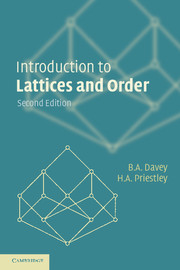Book contents
- Frontmatter
- Contents
- Preface to the second edition
- Preface to the first edition
- 1 Ordered sets
- 2 Lattices and complete lattices
- 3 Formal concept analysis
- 4 Modular, distributive and Boolean lattices
- 5 Representation: the finite case
- 6 Congruences
- 7 Complete lattices and Galois connections
- 8 CPOs and fixpoint theorems
- 9 Domains and information systems
- 10 Maximality principles
- 11 Representation: the general case
- Appendix A: a topological toolkit
- Appendix B: further reading
- Notation index
- Index
Preface to the first edition
Published online by Cambridge University Press: 05 June 2012
- Frontmatter
- Contents
- Preface to the second edition
- Preface to the first edition
- 1 Ordered sets
- 2 Lattices and complete lattices
- 3 Formal concept analysis
- 4 Modular, distributive and Boolean lattices
- 5 Representation: the finite case
- 6 Congruences
- 7 Complete lattices and Galois connections
- 8 CPOs and fixpoint theorems
- 9 Domains and information systems
- 10 Maximality principles
- 11 Representation: the general case
- Appendix A: a topological toolkit
- Appendix B: further reading
- Notation index
- Index
Summary
This is the first textbook devoted to ordered sets and lattices and to their contemporary applications. It acknowledges the increasingly major role order theory is playing on the mathematical stage and is aimed at students of mathematics and at professionals in adjacent areas, including logic, discrete mathematics and computer science.
Lattice theory has been taught to undergraduates at La Trobe University since 1975, and more recently at Oxford University. The notes for these courses were our starting point. The core of the book – Chapters 1, 2 and 5 to 8 – provides a basic introduction to ordered sets, lattices and Boolean algebras and is buttressed by exercises which have been classroom-tested over many years. In a proselytizing article, Order: a theory with a view [in Klassifikation und Ordnung, INDEKS, Frankfurt, 1989], Ivan Rival discusses the modern role of order. The pictorial philosophy he advocates is strongly evident in our approach: diagrams and diagrammatic arguments are stressed in both the text and the exercises.
Prerequisites are minimal. A reader who has taken a course in linear algebra, group theory or discrete mathematics should have sufficient background knowledge and be familiar with our vocabulary and with those symbols not listed in the notation index. To keep the treatment as elementary as possible, we have denied ourselves the formalism of category theory and of universal algebra.
- Type
- Chapter
- Information
- Introduction to Lattices and Order , pp. x - xiiPublisher: Cambridge University PressPrint publication year: 2002



